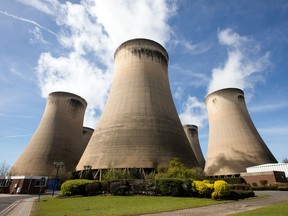Drax Group responds to BBC investigation, says forests are not being harvested for biomass energy

.
british power company Drax Group defends itself following the publication of a BBC investigation alleging that the company is cutting down “old-growth forests” in British Columbia to turn them into wood pellets.
Announcement 2
.
.
The BBC program – which aired on Monday under the title “Green Power Scandal Exposed” — contends that at least some of Drax’s pellets are made from wood that the company has harvested through logging licenses it has obtained from the province, contrary to its own policies and accepted practices that allow the pellets to be labeled as green energy.
After buying from local manufacturers, Drax is the largest producer of wood pellets in BC, owning or having a stake in eight plants and accounting for nearly 80 percent of the province’s production.
Drax uses wood pellets from Canada, which includes sites in Alberta, to supply 15 per cent of the fuel for a large biomass electricity plant in the UK. which has received billions of dollars in green subsidies.
Announcement 3
.
The investigation focused on an area in north-central British Columbia and said it found logs stored in the yards of pellet plants, including at the Meadowbank plant near Quesnel and another near Burns Lake. At the Burns Lake plant, logs are seen being fed into a chipper and into the plant. A BBC reporter also traced a load of logs harvested near Quesnel directly to the Meadowbank plant.
In a written response to Postmedia, Drax officials said the company does not harvest forests and has not taken any material directly from the two areas the BBC examined.
The company said that 80 per cent of the material used to make its pellets in Canada comes from leftovers from lumber production at sawmills, including sawdust, wood chips and bark.
Announcement 4
.
The rest is waste material collected from forests that would otherwise be burned to reduce the risk of wildfires and disease, Drax said.
The company did not answer questions about whether it used whole logs to make pellets and what the quality of those logs was, or what percentage of whole logs contributed to the source material in BC to make pellets.
“Drax’s world-leading sustainable sourcing policies are aligned with the rigorous regulatory frameworks put in place by the Canadian and UK governments, ensuring our operations deliver benefits to nature, climate and people,” they said. Drax officials.
In a press release posted on his websiteDrax stated that the BBC investigative team did not did not contact the company while they were conducting their investigation in Canada to arrange a visit to their facility. “Our lawyers have written to the BBC to remind them of their legal and regulatory rights. obligations and we are considering taking further action,” the company said.
ad 5
.
In a written statement, the BC Ministry of Forestry said the province is following up with Drax to ensure, as the company has stated, that they are not using quality logs harvested from old-growth forests.
It would not make economic sense for a pellet company to do so because, historically, mills have paid up to $25 per cubic meter for fiber obtained from waste collection piles, in contrast to the $140 to $160 per cubic meter pay for a quality used log. to produce timber, said Forest Ministry spokesman Nigel McInnis.
To get the most revenue from each grade of log, quality logs would be sold or traded to sawmills willing to pay this higher price, McInnis said.
Figures provided by the province for 2016 to 2020 show that logs that are not of high quality account for five per cent of the input to pellet mills, with more than 90 per cent coming from sawdust and shavings, wood chips and waste fibers extracted from logged areas. .
ad 6
.
When wood pellets are used to produce electricity, it can be labeled as “green” energy since throughout the growth cycle of the forest, the carbon emitted to produce electricity, or at least some of it, would eventually be captured back into the growing trees. .
Critics, however, point out that while the carbon is emitted now, it takes decades for the forest to grow back.
Ben Parfitt, a resource policy analyst at the Center for Policy Alternatives who was interviewed for the BBC program, said that, at a minimum, Drax and the British Columbia government should provide information to the public about the extent to which whole logs are used. to produce wood pellets. as well as the quality of those records.
With wood supply dwindling and forests under pressure from climate change, there is a question as to whether it is better to leave the wood that is being pelletized uncut or use it for solid wood products that will store carbon for longer periods and will employ more people. Parfitt said.
-
UK energy producer increases its stake in BC’s wood pellet industry
-
BC study links policy changes and registration patterns, shows orientation of old growth
-
BC forestry deferrals ‘mislead the public’ on protecting old-growth stands, critics argue
More news, less ads, faster loading time: Get unlimited, ad-lite access to the Vancouver Sun, Province, National Post and 13 other Canadian news sites for just $14/month or $140/year. Subscribe now through vancouver sun either The province.




